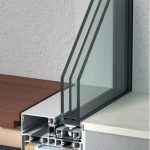Aluminum Frame Windows
Common in window frames from the 1950s through today because of its light weight, high strength, durability, and low cost, aluminum is one of the most common window frame materials. However, historically aluminum frame windows suffer poor thermal performance. This is because aluminum conducts heat faster than almost any other building material.
The solution is superior design of a mixture of materials to retain aluminum’s valuable qualities without its high thermal conductivity. Today’s high-performance aluminum window frame is a sandwich of aluminum on the inside and outside of the frame connected by an incredibly strong polymer (“polyamide” being a common one). You get the durability and strength of aluminum with thermal performance approaching that of wood, uPVC, and fiberglass.
Aluminum’s high strength allows for thin frames; typically much thinner than wood frames. Many desire this minimalist aesthetic. However, thin frames have thermal benefits as well. Although few windows (frame plus glazing) insulate as well as a wall, windows can allow desirable passive solar heating in winter. Thinner frames allow more of the window opening in the wall to be glass, and the sunshine passes only through the glass, not the frame. Depending on the size of a window, the type of window if it opens (casement, hopper, awning, etc.), and the profile of the frame, the frame may take up 10% to 30% of area of the opening in the wall. In addition, frames are typically more conductive than high-performance insulating glazing units (IGUs), so keeping the frame area to a minimum reduces the portion of the window that is most conductive and least insulating.

Tanner. swissFineLine windows appear frameless allowing an invisible boundary between inside and outside without compromising thermal performance. Thermal isolation of the inside from the outside portions of the hidden frame along with triple glazing, warm edge spacers, low-e coatings, and gas fills for performance meeting the Swiss Minergie standard.


